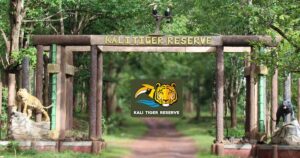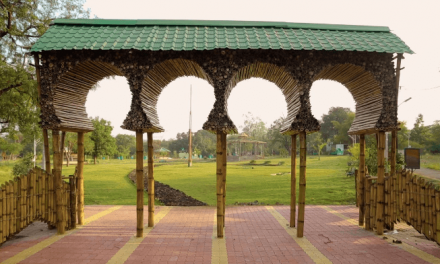
Welcome to the stunning Uttara Kannada District of Karnataka State, home of the Kali Tiger Reserve. KTR, which spans the taluks of Dandeli, Haliyal, Karwar, and Joida, is home to numerous wildlife species, including Bengal tigers. Enjoy tranquil, environmentally friendly lodging in the midst of stunning scenery and a profusion of vegetation.
Between latitudes 14° 57′ 23.04″ N and longitudes 74° 15′ 7.56″ East and latitudes 15° 9′ 56.16″ North and longitude 74° 43′ 10.56″ East, there is a reserve. It is made up of two significant protected areas: Anshi National Park (339.866 sq km) and Dandeli Wildlife Sanctuary (475.018 sq km), which together make up a single tract of protected territory situated in the biologically delicate Western Ghats.
Come along with us as we work to preserve these priceless natural treasures for future generations and take in Kali Tiger Reserve’s breathtaking splendor.
History
On May 10th, 1956, Kali Tiger Reserve the local woodland was designated as the Dandeli Wildlife Sanctuary. The state suggested separating a portion of the sanctuary to create the Anshi national park, and this idea was put into action on September 2nd, 1987.
The original concept was 250 square kilometers in size. When the park area’s final notification was made in 2002, it was expanded by an additional 90 square kilometers.
Geography
The elevation of Kali Tiger Reserve, which is situated in the Western Ghats between 14°54′ and 15°07′ N latitude and 74°16′ and 74°30′ E longitude, varies between 27-1,059 m (89-3,474 ft) above MSL.
Water holes in this area dry out quite early in the summer despite the fact that it rains heavily there because the soil is laterite, and which has a low water-holding capacity.
The tiger reserve’s current name, Kali Tiger Reserve, was given to it in December 2015. The river Kali is the lifeblood of the inhabitants of Uttara Kannada and flows through the Anshi National Park and Dandeli Wildlife Sanctuary.
The name change was intended to raise public awareness of the value of the River Kali to the ecology. Additionally, the name contributed to the tiger reserve having a distinct character.
The Dandeli Tiger Reserve spans 1300 square kilometers and includes two of the most significant protected areas in the area.
They are the Dandeli Wildlife Sanctuary, which spans an area of roughly 475 square kilometers, and the Anshi National Park, which together total an area of 339.866 square kilometers.
Flora
The World Wide Fund for Nature (WWF) has classified both the wet deciduous forests and the montane rain forests of the North Western Ghats ecoregions, which include the park.
The biodiversity of the forests is high.Here, common trees and plants include Garcinia morella, Malabar tamarind, Bintangur, and Calophyllum wightianum.
Fauna
Although they are rarely seen, the park is home to tigers, elephants, and black panthers . The northern plains grey langur, the sambar deer, the spotted deer (chital or axis deer).
The Indian bison, the sloth bear, the Indian wild boar, the bonnet macaque, and various deer are among the other large mammals found here.
https://en.wikipedia.org/wiki/Sloth_bear
The woodlands here are home to pangolins, flying squirrels, Malabar civets, Indian giant squirrels, jackals, jungle cats, leopard cats, little Indian civets, Indian grey mongooses, and wild dogs.
Animals in Kali Tiger Reserve
Despite being a tiger reserve, it is uncommon to see tigers here. Rare black panthers and elephants are also kept here. On the other hand, it can be challenging to spot these species.
In addition, a variety of deer and squirrels can be seen here, along with the Indian bison, sloth bear, bonnet macaque, jackal, porcupine, and wild boar known as Hanuman Langur.
Reptiles:
This location is home to a variety of reptiles, such as the monitor lizard, as well as a variety of snakes, such as the Spectacled Cobra, Bamboo Pit Viper, King Cobra, Russell’s Viper, Saw-Scaled Viper, and Indian Rock Python.
Kali Tiger Reserve provides a variety of nature-inspired and educational camps for both tourists and students. Here are some of the camps offered within the reserve:
- Adventure Camp Castle Rock Nature
- Education Camp Tulgi Nature Education
- Camp Anshi Ever-Green Camp
Visit Information
- The greatest months to visit are October to May.
- The recreation area is open from 6:00 am to 6:00 pm.
- Time Required : 7-8 hrs
- Section Expense : Indians: INR 40,
- Outside Nationals: INR 80
- Safari Timings : Morning – 6:00 AM to 8:00 AM; Evening – 4:00 PM to 6:00 PM
- Safari Cost : INR 2500 to INR 3000 (Incorporates a vehicle, an aide, driver, licenses)
- Best Opportunity to Visit the Safe-haven : October to April
- Safari Length : 3 to 4 hours. With 8 individuals in a jeep.
Kali Tiger Reserve: A Jewel of the Western Ghats
The Kali Tiger Reserve, located in the southern part of the Western Ghats in Karnataka, India, is a sanctuary for tigers and other wildlife species. The reserve, named after the Kali River that meanders through it, is one of the most important conservation areas in India. It is part of the larger Dandeli-Anshi Wildlife Sanctuary, which is a haven for flora and fauna. The Kali Tiger Reserve not only serves as a critical habitat for tigers but also as a biodiversity hotspot with a rich tapestry of ecosystems.
Establishment
The Kali Tiger Reserve is situated in the Uttara Kannada district of Karnataka and was initially established as a sanctuary in 1999, covering an area of approximately 1,100 square kilometers. The reserve itself, however, covers around 600 square kilometers of this sanctuary. The reserve was created to provide a safe and secure environment for tigers, whose population had been dwindling due to poaching and habitat destruction.
The creation of the Kali Tiger Reserve was part of India’s larger effort to conserve the Bengal tiger (Panthera tigris tigris), a species that is both culturally and ecologically significant. The project was initiated under Project Tiger, a national initiative launched in 1973 with the primary aim of protecting the tiger population across the country.
Geography and Climate
The Kali Tiger Reserve lies within the Western Ghats, a mountain range that stretches parallel to the western coast of India. These hills are recognized as one of the world’s eight “hottest hotspots” of biological diversity. The reserve’s landscape is varied and complex, with dense forests, grasslands, rivers, and rolling hills. The Kali River, after which the reserve is named, flows through the reserve, adding to the scenic beauty and ecological richness of the area.
The climate in the Kali Tiger Reserve is tropical and humid, with a significant amount of rainfall throughout the year, especially during the monsoon season (from June to September). The temperature varies, with summer temperatures rising to 40°C, while winter temperatures can drop to around 15°C.
The diversity of the landscape contributes to the habitat variety within the reserve. The forests are a mixture of tropical moist deciduous, semi-evergreen, and evergreen forests, making them perfect for a variety of wildlife species.
Biodiversity and Wildlife
The Kali Tiger Reserve is home to a rich variety of flora and fauna. The diversity of plant life in the reserve supports a vibrant ecosystem that sustains a variety of wildlife. The reserve is part of the Western Ghats, a globally recognized biodiversity hotspot, and is rich in endemic species.
Tigers and Carnivores

As the name suggests, the Kali Tiger Reserve is a key habitat for the Bengal tiger. The reserve’s dense forests and hilly terrain provide the perfect cover for tigers, who are solitary and territorial animals. The tiger population in the reserve is one of the highest in Karnataka, with estimates suggesting around 20-30 tigers residing within the reserve boundaries. The reserve plays a vital role in maintaining a stable tiger population, thanks to effective protection and conservation measures.
Apart from tigers, the reserve is home to other carnivores such as leopards (Panthera pardus), wild dogs (Cuon alpinus), and hyenas (Hyaena hyaena). Leopards are often found in the upper reaches of the hills and are more elusive than tigers. The Indian wild dog, also known as the dhole, is another fascinating predator found in the reserve, living in packs and hunting in groups.
Herbivores and Other Mammals
The Kali Tiger Reserve also supports a variety of herbivores, which provide the necessary prey base for the large carnivores. These include animals such as the Indian bison or gaur (Bos gaurus), the sambar deer (Rusa unicolor), chital (Axis axis), the Indian muntjac (Muntiacus muntjak), and wild boar (Sus scrofa). The presence of these prey species ensures that the food chain within the reserve remains intact.
Other mammals found in the reserve include the Indian elephant (Elephas maximus), which occasionally migrates into the area from neighboring regions. The reserve is also home to smaller mammals like the sloth bear (Melursus ursinus), the striped hyena, and various species of primates, including the bonnet macaque (Macaca radiata) and the Hanuman langur (Semnopithecus entellus).
Avian Diversity
Birdlife in the Kali Tiger Reserve is diverse and abundant. The region’s varied ecosystems, including dense forests, wetlands, and open grasslands, provide an ideal habitat for many bird species. The reserve is home to both migratory and resident birds. Notable species include the Malabar hornbill (Aceros corrugatus), a symbol of the Western Ghats, and the endangered grey-headed fish eagle (Ichthyophaga ichthyaetus).
Other birds that can be found in the reserve include the black-winged kite (Elanus caeruleus), Indian peafowl (Pavo cristatus), white-bellied woodpecker (Dryocopus javensis), and the crested serpent eagle (Spilornis cheela). The birdlife adds to the reserve’s ecological importance and attracts birdwatchers and wildlife enthusiasts.
Reptiles and Amphibians
The Kali Tiger Reserve also harbors a variety of reptiles and amphibians, many of which are unique to the Western Ghats region. Some of the common reptiles found here include the Indian cobra (Naja naja), the king cobra (Ophiophagus hannah), the rock python (Python molurus), and monitor lizards (Varanus spp.). Amphibians such as the Malabar gliding frog (Rhacophorus malabaricus) and the yellow-striped frog (Hoplobatrachus tigerinus) are also found in the reserve.
Conservation Efforts
Conservation efforts in the Kali Tiger Reserve have been crucial in preserving its rich biodiversity. The reserve is part of the broader Project Tiger initiative, which aims to protect tigers and their habitats across India. Efforts in the reserve focus on habitat protection, anti-poaching activities, and managing human-wildlife conflict.
One of the challenges faced by the reserve is the encroachment of human activities, particularly illegal logging, poaching, and land conversion for agriculture. To combat these threats, the Karnataka Forest Department has implemented several strategies to protect the forest and its inhabitants. These include regular patrolling, setting up watchtowers, and installing camera traps to monitor tiger populations.
The involvement of local communities is also essential for the success of conservation efforts. The forest department has partnered with local tribal groups and villagers, educating them about the importance of conservation and offering alternative livelihoods to reduce dependence on forest resources.
Tourism and Ecotourism
Tourism is an important component of the Kali Tiger Reserve’s economy, providing an opportunity for visitors to witness the beauty of the Western Ghats and experience the wildlife of the region. The reserve has been developed with careful planning to ensure that tourism activities are sustainable and do not disturb the delicate ecosystems.
Visitors to the Kali Tiger Reserve can embark on safari tours, which offer a chance to view the reserve’s rich wildlife. These safaris are conducted in a responsible manner to minimize human impact on the habitat. Other activities include nature walks, bird watching, and visiting viewpoints to enjoy the breathtaking landscapes.
Ecotourism is also being promoted as a way to benefit local communities while ensuring the conservation of the reserve’s natural resources. Local guides and eco-friendly lodges provide an immersive experience for tourists while contributing to the region’s economic development.
Challenges and Future Prospects
Despite the ongoing conservation efforts, the Kali Tiger Reserve faces several challenges. One of the most significant challenges is the ongoing human-wildlife conflict. As human settlements expand, tigers and other wildlife sometimes venture into agricultural areas, leading to crop damage and attacks on livestock. Resolving these conflicts requires careful management and engagement with local communities.
Another issue is the loss of habitat due to deforestation and encroachment. While efforts are being made to protect the reserve’s forests, illegal activities like logging and mining continue to pose a threat. Enhanced surveillance, better enforcement of conservation laws, and stronger collaboration with local communities can help address these issues.
In the future, the Kali Tiger Reserve will continue to play a critical role in the conservation of tigers and other endangered species. The reserve’s importance as a biodiversity hotspot is undeniable, and with continued efforts, it can remain a sanctuary for wildlife and a model of sustainable conservation.
Importance of the Kali Tiger Reserve in Ecosystem Conservation

The Kali Tiger Reserve holds a critical role in not only conserving tigers but also protecting the broader ecosystem of the Western Ghats. As one of the most biodiverse regions on the planet, the Western Ghats are home to a wide variety of endemic species, many of which are found only in this region. The reserve, by safeguarding the habitat of apex predators like tigers, plays a vital part in maintaining the balance of this complex ecosystem.
Tigers are keystone species in their habitats, meaning their presence or absence significantly impacts the environment around them. By controlling prey populations, tigers help prevent overgrazing of vegetation, which can lead to habitat degradation. The preservation of tigers, therefore, directly influences the health of the entire ecosystem, affecting plant species, herbivores, and smaller predators alike.
The Kali Tiger Reserve is also a critical part of the larger Dandeli-Anshi Wildlife Sanctuary, a contiguous stretch of forest that allows species to migrate freely. This connectivity between protected areas is crucial for genetic diversity and species survival. For example, tigers need large, uninterrupted areas to roam and hunt, and the reserve’s protected status ensures these large territories are available.
Educational and Research Value
In addition to its role in conservation, the Kali Tiger Reserve is also a significant hub for environmental education and research. The reserve provides ample opportunities for researchers to study tiger behavior, population dynamics, and other aspects of wildlife ecology. The dense forests and varied habitats within the reserve allow scientists to conduct in-depth research on ecosystem interactions and the effects of human activities on wildlife.
Various universities and wildlife organizations collaborate with the forest department to conduct studies on the flora and fauna of the reserve. Data gathered from these studies contributes to better conservation strategies, not just for tigers but for all species living in the area. Educational programs, nature walks, and guided tours offered to visitors allow them to engage with the environment and learn about the critical importance of wildlife conservation.
Community Involvement and Livelihoods
A key aspect of the Kali Tiger Reserve’s success lies in the involvement of local communities in conservation efforts. The forest department has worked with local tribal groups and rural communities to reduce their dependency on forest resources. Many of these communities previously relied on the forest for fuelwood, fodder, and other essentials, which sometimes led to over-exploitation of resources.
Through community-based conservation programs, the reserve has helped create sustainable alternatives for these communities. Local people are trained as eco-guides, which allows them to benefit from the tourism industry. Additionally, villagers are involved in activities such as monitoring wildlife and protecting water bodies, providing them with a direct stake in the protection of the reserve.
Local people also engage in handicraft production, eco-tourism services, and small-scale sustainable agriculture. This holistic approach ensures that conservation and local economic development go hand in hand, reducing conflicts and fostering a sense of ownership over the protected area.
Conclusion: A Model for Sustainable Conservation
The Kali Tiger Reserve is an exemplary model of how conservation efforts can balance ecological integrity with the needs of local communities. Its success as a tiger habitat and biodiversity hotspot underscores the importance of dedicated conservation strategies, community involvement, and long-term management. As challenges such as habitat loss, human-wildlife conflict, and climate change persist, the reserve’s future success will depend on continued vigilance, innovative solutions, and cooperation between governments, conservationists, and local communities.
In conclusion, Kali Tiger Reserve stands as a testament to India’s ongoing commitment to wildlife conservation. By protecting its tigers and the many species that share their environment, the reserve helps safeguard the ecological balance of the Western Ghats. Its conservation efforts provide hope for the future, not just for tigers, but for the entire biodiversity of this unique region.
The Kali Tiger Reserve is a precious natural resource and a vital sanctuary for the Bengal tiger, along with a myriad of other species that call the reserve home. Located in the heart of the Western Ghats, it represents the confluence of ecology, wildlife conservation, and human interaction with nature. While challenges remain, the reserve continues to be a beacon of hope for wildlife conservation in India, and it offers valuable lessons for balancing the needs of people and wildlife in an increasingly interconnected world. The efforts at Kali Tiger Reserve exemplify the significance of protecting our natural heritage, ensuring that future generations can experience and appreciate the diversity of life that thrives in this magnificent region.
For more information about different tiger reserve please visit:- /https://yesnearme.com/news/







Recent Comments